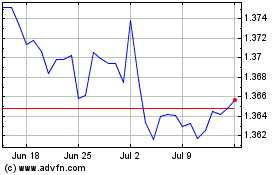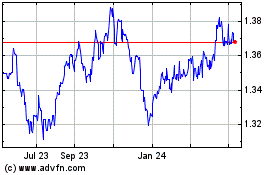Canadian Dollar Extends Rally After Upbeat GDP, Jobs Data
December 01 2017 - 4:28AM
RTTF2
The Canadian dollar extended its early rally against its major
counterparts in the European session on Friday, following the
release of nation's robust jobs data for November and better than
forecast GDP for September. Data from Statistics Canada showed that
the employment increased for the second consecutive month in
November. The employment rose by 79,500 jobs, following an increase
of 35,300 jobs in September. Economists had forecast an uptick of
10,000 jobs. The unemployment rate fell by 0.4 percentage
points to 5.9 percent, the lowest rate since
February 2008. This beats forecast for a drop to 6.2 percent
and follows a reading of 6.3 percent in the preceding month.
Separate data from the same agency showed that nation's economic
growth improved more than forecast in September. On a seasonally
adjusted monthly basis, the GDP rose 0.2 percent in September
after edging down 0.1 percent in August. Economists were
looking for a gain of 0.1 percent. On an annualized basis, the GDP
improved 1.7 percent on the third quarter, exceeding forecasts for
an increase of 1.6 percent. The second quarter estimate was revised
to 4.3 percent, which has been initially reported as a 4.5 percent
rise. Oil prices are higher after OPEC agreed to extend its supply
quota plan with Russia through 2018. Crude for January delivery
rose $0.49 to $57.89 per barrel. The currency rose against its most
major counterparts in the Asian session, as oil prices rose after
the OPEC and Russia decided to extend their oil production cuts to
the end of 2018. The loonie hit a 9-day high of 0.9652 against the
aussie, off its previous low of 0.9768. On the upside, 0.95 is
possibly seen as the next resistance for the loonie. The loonie
climbed to 88.45 against the yen, its strongest since November 17.
The pair closed Thursday's trading at 87.25. If the loonie rises
further, 90.00 is likely seen as its next resistance level. Survey
from Nikkei showed that Japan's manufacturing sector continued to
expand in November, and at a faster pace with a 44-month high PMI
score of 53.6.
That's up from 52.8 in October, and it moves further above the
boom-or-bust line of 50 that separates expansion from
contraction.
The loonie that closed Thursday's trading at 1.2895 against the
greenback strengthened to a 4-day high of 1.2741. The loonie is
seen finding resistance around the 1.26 mark. The loonie spiked up
to a 1-week high of 1.5127 against the euro, from a low of 1.5357
hit at 7:45 pm ET. The next possible resistance for the loonie is
seen around the 1.50 mark.
Survey data from IHS Markit showed that Eurozone manufacturing
activity expanded notably in November underpinned by production and
new orders.
The final factory Purchasing Managers' Index rose to 60.1 in
November, its best reading apart from April 2000's series-record
high. The score improved from 58.5 in October.
Looking ahead, U.S. ISM manufacturing index for November and
construction spending for October are due shortly.
US Dollar vs CAD (FX:USDCAD)
Forex Chart
From Mar 2024 to Apr 2024

US Dollar vs CAD (FX:USDCAD)
Forex Chart
From Apr 2023 to Apr 2024
